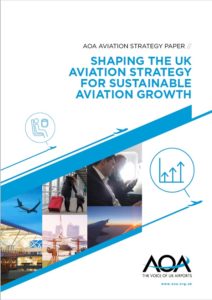Towards a smooth and improved Border
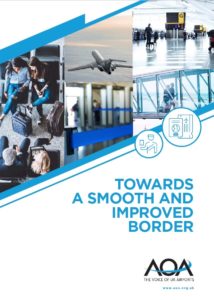 Airports are our gateways to the world and the first experience of the UK for arriving visitors. Given this vital role, it is essential Border Force operates effectively and to high standards in airports. However, this report sets out that Border Force’s resources are declining while passenger numbers are growing. As a result, passengers experience ever-longer queues at passport control.
Airports are our gateways to the world and the first experience of the UK for arriving visitors. Given this vital role, it is essential Border Force operates effectively and to high standards in airports. However, this report sets out that Border Force’s resources are declining while passenger numbers are growing. As a result, passengers experience ever-longer queues at passport control.
In response to this challenge, our report sets out how to better meet passenger expectations for shorter waiting times and ensure the UK has a secure but welcoming border:
- The Government should provide urgent clarity on post-Brexit Border arrangements; Government should seek either to maintain the same entry-clearance system for EU nationals after Brexit or to provide funding for the extra capacity airports will require to meet that changed demand.
- A clear, long term resource plan: to meet the growth challenge, provide a clear welcome to the UK and meet passenger expectations, Border Force needs a long-term strategy
with an accompanying budget to deliver the resources that will be needed. - A framework to encourage innovation: Government should provide a framework which allows Border Force to work with the supply side of industry to understand what new technologies and innovations might be practicable, and to explore the circumstances under which they could be implemented.
- Passenger-focussed performance metrics: The forthcoming Aviation Strategy process offers a prime opportunity for Government and industry to work together to explore new mechanisms for measuring performance at the border.
Our vision for a UK Aviation Strategy
With record passenger numbers that are set to continue to grow at pace in the coming years, UK aviation is preparing for the future. To support the industry, the UK Government has launched a consultation process to develop a UK Aviation Strategy. In a position paper, the AOA sets out that airports are looking for a Strategy that goes beyond a “statement of intent” and gives industry the tools necessary to prepare and build for the future. Already, more than £8bn of investment in airport facilities is planned over the next five years. A robust Aviation Strategy will give airports the certainty to make the next set of long-term investment decisions and enable them to work with partners, such as local authorities and communities, to develop plans that will benefit local communities and economies.
The UK Aviation Strategy should include:
- A road-map to creating better, sustainable surface transport to airports, including how Government expects organisations like Network Rail, Highways England and devolved bodies to deliver on that road-map
- Go beyond a statement of intent and give industry the necessary tools to deliver sustainable growth to meet increasing demand for air travel, including lifting planning caps on air transport movement and supporting additional terminal and runway capacity as and when necessary
- Work cross-Government to put the passenger first: reducing UK Air Passenger Duty, Europe’s highest such tax, and supporting Border Force to provide not only a secure UK border but also excellent customer services to travellers.
AOA Election Manifesto 2017
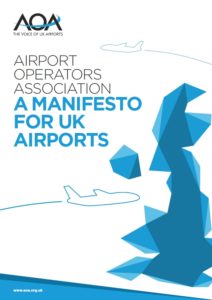 Ahead of the 2017 General Election, the AOA released a manifesto that set out the AOA’s priorities for the new Government. It detailed how building on the success of the aviation sector will support the Government’s ability to meet its policy priorities. For example, aviation will be able to help deliver on the opportunities offered by the UK’s exit from the EU by providing the vital overseas connectivity a truly global Britain will require. Similarly, a new Aviation Strategy is needed to underpin a new Government’s growth agenda, supporting job creation and investment across the country, and through this enable other businesses to grow as well.
Ahead of the 2017 General Election, the AOA released a manifesto that set out the AOA’s priorities for the new Government. It detailed how building on the success of the aviation sector will support the Government’s ability to meet its policy priorities. For example, aviation will be able to help deliver on the opportunities offered by the UK’s exit from the EU by providing the vital overseas connectivity a truly global Britain will require. Similarly, a new Aviation Strategy is needed to underpin a new Government’s growth agenda, supporting job creation and investment across the country, and through this enable other businesses to grow as well.
The manifesto set out five priorities:
- Create an Aviation Strategy that supports sustainable airport growth across the country
- Prioritise a new legal framework for the UK’s aviation connectivity after Brexit
- Set out a vision and policy framework to modernise airspace
- Review and cut Air Passenger Duty to boost the UK’s international competitiveness
- Ensure that the UK’s border regime is secure but welcoming
A full copy of the manifesto can be found here.
Connecting the UK economy
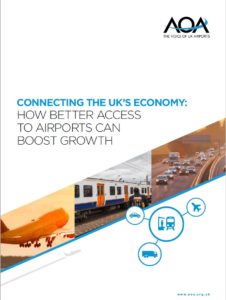 The AOA report on surface access (published in November 2016 and available here) sets out the economic case for how improved and more efficient access to airports will enable aviation to deliver more for the local and wider economy, creating tens of thousands of jobs in the process. To deliver these new and additional economic benefits to the UK economy, we are calling for the Government to work towards a more integrated transport policy.
The AOA report on surface access (published in November 2016 and available here) sets out the economic case for how improved and more efficient access to airports will enable aviation to deliver more for the local and wider economy, creating tens of thousands of jobs in the process. To deliver these new and additional economic benefits to the UK economy, we are calling for the Government to work towards a more integrated transport policy.
The report, conducted in conjunction with Capital Economics, outlines that improvements to transport links significantly boost the catchment areas of airports. By enabling more passengers to travel to an airport, this investment attracts a greater number of airlines, in turn offering more destinations and at higher frequencies. This ultimately benefits both businesses and the consumer. Specifically, a 5% improvement in average journey times to and from airports could deliver a 2.7% increase in passenger numbers, generating an additional £1.9 billion for the UK economy and supporting an additional 32,000 jobs.
The AOA called on the Government to better assess the level of transport infrastructure connecting UK airports and identify where there are gaps in present and future demand. It should then work with Network Rail, the Highways Agency and local government to prioritise improvement projects at airports in future infrastructure investment plans to address the issues identified and deliver much-needed improvements for passengers and freight alike.
Tourism and Aviation
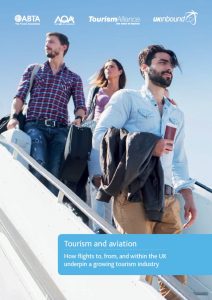 The AOA, ABTA – the Travel Association, the Tourism Alliance and UKinbound, worked together on this report (published in June 2015, available here) to examine the value of tourism and aviation and how flights to, from, and within the UK underpin a growing tourism industry.
The AOA, ABTA – the Travel Association, the Tourism Alliance and UKinbound, worked together on this report (published in June 2015, available here) to examine the value of tourism and aviation and how flights to, from, and within the UK underpin a growing tourism industry.
The report shows that the UK’s aviation and tourism industries are deeply interconnected: a healthy tourism industry relies on a healthy aviation industry and vice versa. With 73% of visitors to the UK travelling by air, a strong aviation sector is an enabler of a successful tourism industry. The tourism industry generated almost a third of all additional jobs created in the UK since 2010. Importantly, these jobs were created throughout the UK, supporting the recovery of regional economies. Meanwhile, inbound tourism-related export earnings increased by 26.5% to £24 billion between 2009 and 2014.
The report called on the Government to recognise tourism and aviation’s vital roles in the economy and to invest in policies that will help both sectors develop further. A commitment to sustaining world-class air connectivity, reviewing and cutting Air Passenger Duty and improving the competitiveness of the UK’s visa system to make the UK more accessible are just some of the policies that will help to boost tourism and contribute to a growing economy in the years to come.
Sustainable Airports
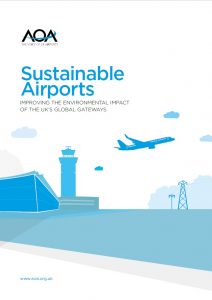 Airports are the UK’s gateways to the world: they are hives of commercial and social activity that drive our international and domestic connections, our business trips and holidays. In this report (published in September 2014 and available here), the AOA demonstrates that airports are also responsible businesses, working to meet the environmental objectives and expectations of policy makers and local communities.
Airports are the UK’s gateways to the world: they are hives of commercial and social activity that drive our international and domestic connections, our business trips and holidays. In this report (published in September 2014 and available here), the AOA demonstrates that airports are also responsible businesses, working to meet the environmental objectives and expectations of policy makers and local communities.
The report shows that the carbon footprint of the UK’s 18 largest airports (by passenger numbers), which represent 95% of air passengers, reduced by almost 3% in just two years, despite passenger numbers increasing by more than 5% and air traffic by almost 2% during the same period.
On noise near airports, the report notes that areas affected by noise around airports (known as noise contours) are getting smaller and that airports are investing significantly investing in local community engagement. The population size within noise contours is, however, beyond airport control: while government policy asks airports to limit and reduce the number of people affected by noise, it is still possible for developers to get planning permission to build in the noise contours. From 2011-2014, for example, over 5,700 homes had been given planning permission or started or completed construction within airport noise contours.
In the report, the AOA called on the Government for policy support in two main ways:
- On carbon, the Government needs to work with the aviation sector to incentivise the take-up of sustainable aviation fuels, a priority also outlined in the AOA’s 2017 election manifesto; and
- On noise, the Government needs to give local authorities national policy guidance to help them build homes in areas that are compatible with airports and other infrastructure, but which do not cut across national aviation policy.
Airports in the community
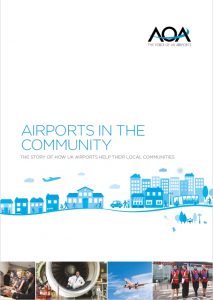 In this report (published in June 2014 and available here), the AOA highlights the impressive and diverse work airports also undertake in their local areas – the first time such information has been presented together. The report shows that – as well as being economic enablers and major employers – airports are at the centre of their local communities, providing training and apprenticeships, assisting local charities, and inspiring schoolchildren and young entrepreneurs in their local areas.
In this report (published in June 2014 and available here), the AOA highlights the impressive and diverse work airports also undertake in their local areas – the first time such information has been presented together. The report shows that – as well as being economic enablers and major employers – airports are at the centre of their local communities, providing training and apprenticeships, assisting local charities, and inspiring schoolchildren and young entrepreneurs in their local areas.
Airports also provide local employment, offer commercial opportunities to businesses in the supply chain, and provide essential national and international connectivity.
The importance of airports to their local communities is often overlooked in the debates over airport expansion and aviation taxation. The AOA hopes this report will go some way to redressing the balance, demonstrating another side to aviation, a sector which we in the UK excel at and which will continue to play such a vital role in the UK’s economic recovery.


